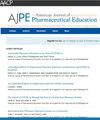语言交际策略(模糊限制语和强化语)在模拟药学教育共同决策中的应用。
IF 3.5
4区 教育学
Q1 EDUCATION, SCIENTIFIC DISCIPLINES
引用次数: 0
摘要
目的:模糊限制语和强化语是一种语言策略,用来表示对个人面部需求的尊重,特别是他们渴望感到自主或成为社会群体的一部分。本研究旨在调查药剂学学生在客观结构化临床检查(OSCE)中使用这种语言策略及其对沟通等级的影响,重点关注患者和开处方者对药剂师建议的共同决策和吸收。方法:对成绩差、中等和良好的欧安组织视频进行分析观察回顾性队列研究。在礼貌理论的基础上,使用总结性内容分析和统计分析,识别、映射和比较了交际等级之间模糊限制语和强化语的使用。结果:总体而言,学生在与医生(1253对565)和患者护理人员(2026对369)互动时使用的模糊限制语多于强化语。最常见的模糊限制语是情态助动词(27.5%);而最常见的强化词是高强度副词(47%)。被标记为良好沟通的学生在与护理人员交谈时使用的模糊措辞比医生少(中位数为42比29),而被标记为沟通技巧较差的学生(中位数为42比38)。结论:总体而言,药学专业学生在提出建议时倾向于回避。被考官打高分的学生在与病人或医生交谈时使用的模糊限制语数量有所不同,而被打为不善沟通的学生在与病人或医生交谈时使用的语言相似。研究结果揭示了评分与使用的语言策略之间的联系,并可以为学生和考官提供创新的应用语言交流培训计划,这可能会使毕业生准备好利用语言策略在工作场所传达药剂师的建议。本文章由计算机程序翻译,如有差异,请以英文原文为准。
Use of Linguistic Communication Strategies (Hedges and Intensifiers) in Simulated Pharmacy Education Shared Decision-Making
Objective
Hedges and intensifiers are linguistic strategies that are used to indicate respect for an individual's face needs, particularly their desire to feel autonomous or part of a social group. This study aimed to investigate the use of such linguistic strategies by pharmacy students and their impact on communication grades in an Objective Structured Clinical Examination, focusing on shared decision-making and uptake of pharmacists’ recommendations by patients and prescribers.
Methods
An analytical observational retrospective cohort of Objective Structured Clinical Examination videos across poor, average, and good grades was conducted. Underpinned by politeness theory and using summative content analysis and statistical analysis, the use of hedges and intensifiers was identified, mapped, and compared across communication grades.
Results
Overall, students used more hedges than intensifiers when interacting with physicians (1253 vs 565) and patients’ carers (2026 vs 369). The most common hedges were modal auxiliary verbs (27.5%), whereas the most common intensifiers were high-strength adverbs (47%). Students who were marked as good communicators were seen to use less hedges when speaking with carers than physicians (median 42 vs 29) vs students who were marked with poor communication skills (median 42 vs 38).
Conclusion
Overall, pharmacy students tend to hedge when making recommendations. Students who were marked highly by examiners showed differences in the number of hedges between the 2 interlocutors, whereas students who were marked as poor communicators used similar language when talking to the patient or the physicians. Study findings provide insight into links between grading and linguistic strategies used and could inform innovative applied linguistic-based communication training programs for students and examiners, which could lead to preparing graduates to utilize linguistic strategies to communicate pharmacist-led recommendations in the workplace.
求助全文
通过发布文献求助,成功后即可免费获取论文全文。
去求助
来源期刊
CiteScore
4.30
自引率
15.20%
发文量
114
期刊介绍:
The Journal accepts unsolicited manuscripts that have not been published and are not under consideration for publication elsewhere. The Journal only considers material related to pharmaceutical education for publication. Authors must prepare manuscripts to conform to the Journal style (Author Instructions). All manuscripts are subject to peer review and approval by the editor prior to acceptance for publication. Reviewers are assigned by the editor with the advice of the editorial board as needed. Manuscripts are submitted and processed online (Submit a Manuscript) using Editorial Manager, an online manuscript tracking system that facilitates communication between the editorial office, editor, associate editors, reviewers, and authors.
After a manuscript is accepted, it is scheduled for publication in an upcoming issue of the Journal. All manuscripts are formatted and copyedited, and returned to the author for review and approval of the changes. Approximately 2 weeks prior to publication, the author receives an electronic proof of the article for final review and approval. Authors are not assessed page charges for publication.

 求助内容:
求助内容: 应助结果提醒方式:
应助结果提醒方式:


